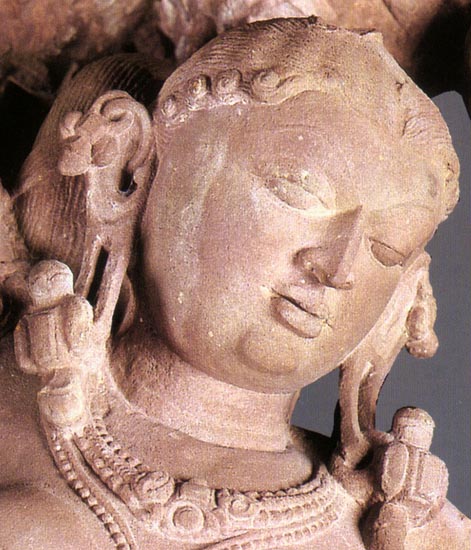
A Maiden, a Monkey, and the Mango Tree
India (Rajasthan or Madhya Pradesh), ca. 850
Pink sandstone, 25 1/2 x 14 in (64.8 x 35.6 cm)
Published: Heeramaneck 1979, no. 69; Ray 1986, p. 189, fig.3;
Desai and Mason 1993, p. 209, no. 41; Dehejia l999, p. 375, no. 111
|
Originally, this sculpture would have functioned as a bracket figure seemingly supporting the ceiling of a hall in a temple. It would not have been easily visible, partly because of its position and partly because of the absence of sufficient light. Even if the interior were well lighted, few devotees would have admired the figure's beauty as they walked through the hall towards the shrine. Out of context, however, one can letter appreciate its elegance and charm, which is enhanced by its apparent three-dimensionality. The well-endowed young woman has opulent breasts and luxuriant hips, both of which gain one's attention by their contrapuntal swing, a loosely knotted string on her left thigh, and a swaying strand of pearls in her cleavage. Her bent hand and the downward gaze of her eyes emphasize her demureness; otherwise, her face shows little emotion. She certainly does not seem to be aware of the headless monkey with a mango in its hand perched on her raised right rm. Her broken left hand would have touched one of the bunches of hanging fruit. Thus, not only does she appear pensive and remote, but her size, relative to that of the monkey and the tree, makes her of Amazonian proportions, thereby indicating her celestial rather than terrestrial nature. While her arm is clearly idealized, the leaves and fruit of the tree and the monkey are more realistically rendered. Woman-under-the-mango-tree has remained a favorite motif for bracket figures in India since antiquity. Fruit-laden mango trees, a familiar and welcome sight in late spring and summer throughout the land, were a natural choice to symbolize fecundity and plenitude. In Indian literature, the woman is frequently said to bend from the weight of her breasts, just as the mango tree does from its fruit. But the mango is not merely a metaphor for fertility. The tree is also considered to be "the most perfect of all trees, sweet of flower and fruit, thick of shade" (Ingalls 1965, p.303). These qualities are also admired in the perfect wife. The sculpture very likely once graced a temple somewhere in Rajasthan or Madhya Pradesh, from where several similar figures have entered American collections. Most noteworthy of these are two panels showing river goddesses, now in the Los Angeles County Museum of Art (Pal 1988, pp. 116-18, no. 45). All carved from the same rust-colored sandstone, these figures are informed with a baroque luxuriance of form and languid grace reflected also in the Sanskrit poetry of the period, as, for instance, in the following passage of Shri Harsha, the poet-king (died 648): My lady come very slowly. The weight of thy breasts just tire out
thy
all
text and images © The Trustees of the Walters Art Gallery, Baltimore
|
